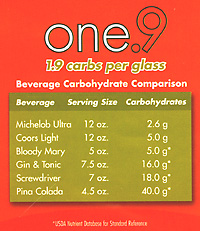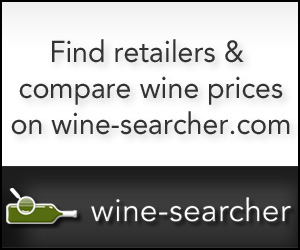|
One.9, One.6, 2 thumbs up
The regulation allows the use of "low-carb" on any wine containing fewer than 7 grams of carbohydrates in a 5-ounce glass. In fact, virtually all dry table wines, and most off-dry bottlings, can easily meet this not-so-strict requirement. Only the sweeter style of White Zinfandels and other mass-market "blush" wines, and of course sugary dessert wines, fail to limbo-dance under the 7-gram threshold. But with as many as 60 million Americans shunning carbohydrates as they follow such trademarked dietary regimens as Atkins and the South Beach diet, it doesn't take a marketing genius to see that there's money to be made by offering a wine that appears to fit neatly into these trendy diet plans. Brown-Forman Corp., the Louisville-based drinks conglomerate, raised the bar with its announcement of a pair of California wines named after their carbohydrate count: One.6 Chardonnay and One.9 Merlot. These carb levels, although well within the normal range for bone-dry table wines, appear to be significantly below many of the firm's competitors in the mass-market niche, where "threshold sweetness" in the range of 3 or 4 grams per serving is commonplace. Made at Brown-Forman's Valley Oaks winery in Hopland, Mendocino County (best known as the source for the widely distributed Fetzer brand), both low-carb products are under the charge of women wine makers: Cara Morrison, who's in charge of white wines at Fetzer and Brown-Forman's Jekel label, makes the One.6 Chardonnay; Nancy Walker, who makes Fetzer's reds and Brown-Forman's upscale Mariah Zinfandel, oversees the One.9 Merlot. Both wines are labeled "California," allowing production from grapes grown throughout the state, taking advantage of the region's ongoing "glut" of grapes and bulk wine. The low-carb wines are tagged at $9.99 "suggested retail" for a standard 750 ml. bottle, although industry sources predict that they'll likely go for $7 to $9 in the marketplace, where demand is already booming. Brown-Forman took orders for more than 200,000 cases within two weeks after the product announcement, much of it from mass-market chains such as Walmart, Target, Safeway, RiteAid and Albertson's. There's also reportedly considerable interest in the restaurant sector, particularly "upscale casual" chains. So how do the wines stack up? Is there substance behind the flash? Since Brown-Forman's elegant old headquarters is just a few miles from here, I dropped by the other day and persuaded them to part with a couple of samples. Back home, to avoid coloring my wine-tasting perceptions with opinions (rational or otherwise) about the merits of marketing wine as "low-carb," I tasted both of Brown-Forman's new wines "blind," having them poured out of my sight and served in unmarked glasses, paired with other California wines of the same grape variety and similar price range and market niche. The results? The low-carb wines fared well ... surprisingly well. In each pairing, the Brown-Forman product stood out as dry, crisp, acidic, structured ... relatively "European" in style, compared with the competitive wines, which showed relatively fat flavors touched with a hint of mellow sweetness. In short, the competitive wines both adhere to the current mass-market model, assuming that many people who aren't seriously into wine, as the old saying goes, "talk dry but drink sweet." Although the equation isn't exact - Brown-Forman experts tell me that the wine makers were somewhat surprised to find that the relationship between fermenting out the last of the grape sugar and reducing carbs was not exactly linear - it's still safe to assume in general that the drier (the more unsweet) the wine, the lower the carb count. So, by producing a wine that can be labeled very low in carbs, they've coincidentally come up with a mass-market wine that's more to a serious "wine geek's" liking than its competitors. But the multimillion dollar question, it seems to me, is whether the mass market, with its natural sweet tooth, will be excited enough about the idea of a low-carb wine to accept a dryer, more tart alternative. And that's a tale that will be told by hard, cold sales figures, not tasting notes. Tasting the new low-carb wines Here's my tasting report on all four wines. They're all pleasant enough, frankly; if offered any of them at a party, I wouldn't decline. The wines were tasted both with and without food, and both the reds and whites went nicely with an Italian-style dish of chicken braised with tomatoes and onions on a bed of orzo pasta. 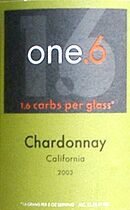 One.6 2003 California Chardonnay ($9.99)
One.6 2003 California Chardonnay ($9.99)
This clear, pale straw-color wine shows fresh and pure apple aromas with just a hint of spice, pleasant and characteristic Chardonnay. It's crisp and clean on the palate, ripe appley fruit and a good dash of fresh-fruit acidity to give it balance. Its "unsweet" dry flavor sets this one apart from mass-market Chardonnays, and in my mind, this is a distinct advantage. It reminds me, in a good way, of a modest Macon-Villages. (Nutritional information: Serving size, 5 fl. oz.; calories, 120; carbohydrates, 1.6 grams; protein, 0.5 grams; fat, 0.0 grams.)  Rex Goliath 2002 "47 Pound Rooster" California Central Coast Chardonnay ($8)
Rex Goliath 2002 "47 Pound Rooster" California Central Coast Chardonnay ($8)
Clear, pale straw color, with an appley scent and a good, round mouthfeel, this one's not bad either, but a distinct edge of threshold-level sweetness with barely compensating acidity makes it a bit less crisp and refreshing. Give the low-carb wine the edge on style points in the white-wine battle, even if you're not counting carbs. (Nutritional information not disclosed.) 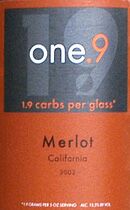 One.9 2002 California Merlot ($9.99)
One.9 2002 California Merlot ($9.99)
A bluish-purple tinge adds depth to this ruby-color wine. Light but pleasant black-cherry aromas lead into a nicely balanced if somewhat lightweight flavor profile focused on tart-cherry fruit; a whiff of cinnamon adds a pleasantly exotic scent, and crisp acidity and just a hint of tannic astringency provide desirable structure. This contest is a closer call than the white-wine "battle," but I give this wine the edge because its comparative austerity suits my personal prefernce for "Old World" wines; still, I wonder whether this style will resonate with Brown-Forman's target market. (Nutritional information: Serving size, 5 fl. oz.; calories, 125; carbohydrates, 1.9 grams; protein, 0.5 grams; fat, 0.0 grams.) 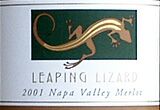 Leaping Lizard 2001 Napa Valley Merlot ($10)
Leaping Lizard 2001 Napa Valley Merlot ($10)
Clear ruby in color and mellow on the nose and palate, a whiff of butter surrounds forward plums and cherries and a dash of pleasant green herbal character in this soft and fruity Merlot. It's a crowd-pleasing quaffer, with sufficient acidity to hold it together, but again, if I were scoring on a point system I would have to give the edge to the low-carb wine. (Nutritional information not disclosed.)
TALK ABOUT WINE ONLINE If you prefer to comment privately, feel free to send me E-mail at wine@wineloverspage.com. I'll respond personally to the extent that time and volume permit.
SUBSCRIBE: Administrivia To subscribe or unsubscribe from The 30 Second Wine Advisor, change your E-mail address, or for any other administrative matters, please use the individualized hotlink found at the end of your E-mail edition. If this is not practical, contact me by E-mail at wine@wineloverspage.com, including the exact E-mail address that you used when you subscribed, so I can find your record. We do not use our E-mail list for any other purpose and will never give or sell your name or E-mail address to anyone. I welcome feedback, suggestions, and ideas for future columns. To contact me, please send E-mail to wine@wineloverspage.com All the wine-tasting reports posted here are consumer-oriented. In order to maintain objectivity and avoid conflicts of interest, I purchase all the wines I rate at my own expense in retail stores and accept no samples, gifts or other gratuities from the wine industry.
Friday, May 21, 2004 |

